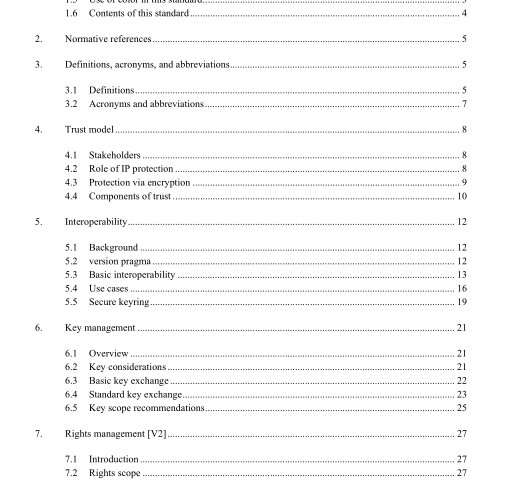IEEE 1735-2014 pdf download.IEEE Recommended Practice for Encryption and Management of Electronic Design Intellectual Property (IP)
4. Trust model
It is necessary for the stakeholders in IP protection to trust each other in order to do business. If one is to understand how encryption plays a role and therefore to trust it sufficiently, one needs to have a concept of the trust model it supports. In general, understanding the trust model helps one decide that a given security mechanism is appropriate to achieve the security objective. This clause identifies the stakeholders and their interests. It explains the role of IP protection, how it can be achieved via encryption, and why it is valuable. Finally, the components of the trust model are examined to understand the foundation they provide for trusting this form of IP protection.
4.1 Stakeholders
In any transaction there are parties of interest, those who hold a stake in the outcome of the transaction. Within this trust model, there are three primary stakeholders who represent the spectrum of concerns: the IP author, the IP user, and the tool vendor. The IP author stakeholder is the legal owner of the IP and is the grantor of any rights that are conveyed in the course of transactions involving that IP. The nature of the rights offered and the compensation demanded for those rights are specified by the IP author. Their interest includes providing a valuable product and preventing loss through disclosure of their IP to either competition or IP users.
Their ultimate interest is maximizing their return on investment in the IP. The IP user stakeholder is the receiving party who seeks possession and rights to the IP to further their own interests. After providing satisfactory compensation to the IP author, the IP user receives the transacted rights to use the IP. Their interest includes choosing the right IP of the appropriate usefulness and quality and minimizing the risk and cost of mistakes in doing so. Their ultimate interest is in minimizing the total cost to use the right IP in their designs. The tool vendor stakeholder provides a tool to the IP user that is enabled to work with the IP. Indeed, they provide a tool to the IP author as well. Here, the tool provides an IP protection mechanism based on encryption that can be used by the IP author to deliver protected IP to the IP user.
This mechanism allows the IP user to work with the tool for its intended purpose with that protected IP, while providing a high barrier to disclosure of the IP. The tool vendor interests are similar to those described for the IP author; they include providing a valuable product, their tool, and preventing loss through disclosure of tool features and internal behavior to their competition. Their ultimate interest is maximizing their return on investment in the tool, which includes the investment in the IP protection mechanism.
4.2 Role of IP protection
The pricing of an IP is based on a complex set of factors. Accounting for the risk of loss due to disclosure is one of them. Though not commonly itemized, it is fair to assume this adds a premium to the compensation demands of an IP author.
It is referred to here as the risk premium. The goal of an IP protection mechanism is to mitigate the risk of loss due to disclosure. IP protection through encryption is one mechanism, but there are many others, including altering the representation of the IP through obfuscation or abstraction, limiting access to secure, fixed, “brick and mortar” locations, and a variety of legal mechanisms. None of these are perfect. An IP protection mechanism provides a degree of trust that a loss does not happen. An IP protection mechanism itself may have considerable cost to employ, which is a part of the risk premium.IEEE 1735 pdf download.IEEE 1735-2014 pdf download
IEEE 1735-2014 pdf download

Leave a Reply